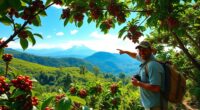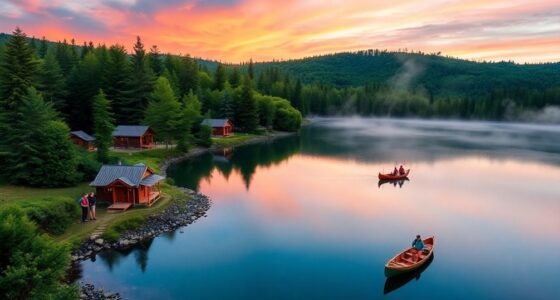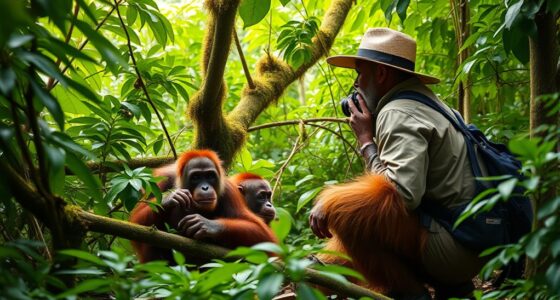Experience authentic Indigenous-led wilderness adventures in Haida Gwaii, where guides share stories, legends, and traditions that connect you to the land and sea. You can explore sacred sites, learn traditional crafts, and enjoy eco-friendly activities that support cultural preservation and environmental stewardship. These journeys foster a deep understanding of Haida heritage while promoting sustainable practices. Keep exploring to discover how you can participate respectfully and support ongoing Indigenous initiatives in the region.
Key Takeaways
- Indigenous guides lead authentic land and sea wilderness tours, sharing Haida stories, legends, and cultural practices.
- Participants engage in traditional ceremonies, rituals, and craftsmanship to deepen cultural understanding.
- Eco-friendly wilderness expeditions emphasize land and sea stewardship, conservation, and sustainable practices.
- Tours include visits to sacred sites and participation in ancestral activities, fostering respectful cultural connections.
- Indigenous-led initiatives focus on community empowerment, cultural preservation, and eco-tourism development.
The History and Significance of Haida Gwaii
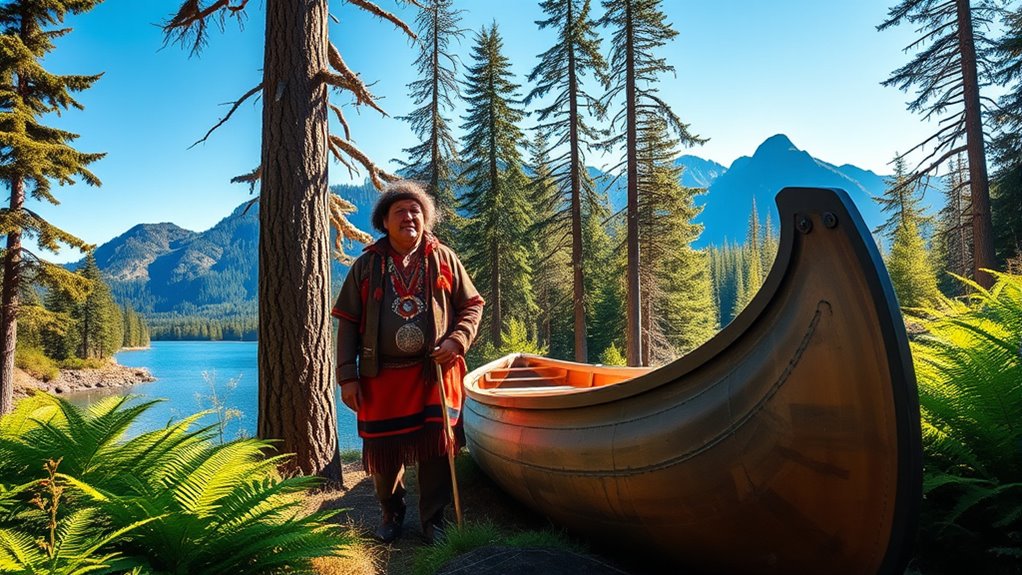
Haida Gwaii, often called the “Islands of the People,” holds immense cultural and historical importance for the Haida Nation. You can feel this rich heritage through traditional storytelling, which passes down legends, history, and values from generation to generation. Indigenous art flourishes here, with intricate carvings, totem poles, and jewelry reflecting the Haida’s spiritual beliefs and connection to nature. These artistic expressions are more than decoration; they are storytelling tools that preserve stories and history. As you explore Haida Gwaii, you’ll witness how these traditions remain alive, shaping the identity of the Haida people today. The land, stories, and art intertwine, creating a profound sense of cultural significance that guides your understanding of this remarkable place. Incorporating traditional art forms into daily life helps sustain cultural practices and fosters community resilience. The importance of cultural preservation is evident in how these practices are actively maintained and celebrated by the Haida community.
Principles of Indigenous-Led Tourism

Indigenous-led tourism prioritizes authentic cultural experiences and respects the sovereignty of Indigenous communities. You’ll find that storytelling is at its core, with Indigenous guides sharing their histories, legends, and insights through indigenous storytelling that preserve and honor their traditions. Traditional art also plays a crucial role, offering visitors a window into the community’s identity and values. These principles ensure that tourism benefits the community directly, empowering them to control how their culture is presented. Respect for the land and environment guides every activity, emphasizing sustainability and stewardship. By centering Indigenous voices and knowledge, this approach fosters genuine connections and understanding. Additionally, affiliate disclosures help maintain transparency about the financial aspects of tourism partnerships. Emphasizing regional flavors and traditions, this approach invites you to experience Haida Gwaii through a lens rooted in respect, tradition, and community empowerment. Incorporating cultural preservation ensures that the community’s heritage remains vibrant and protected for future generations. Recognizing the importance of Indigenous-led initiatives, communities can share their stories on their own terms, ensuring authenticity and cultural integrity are maintained. Furthermore, implementing predictive modeling can support sustainable tourism planning by forecasting visitor impacts and resource needs, ultimately benefiting the community and environment.
Authentic Cultural Experiences Offered by Haida Communities
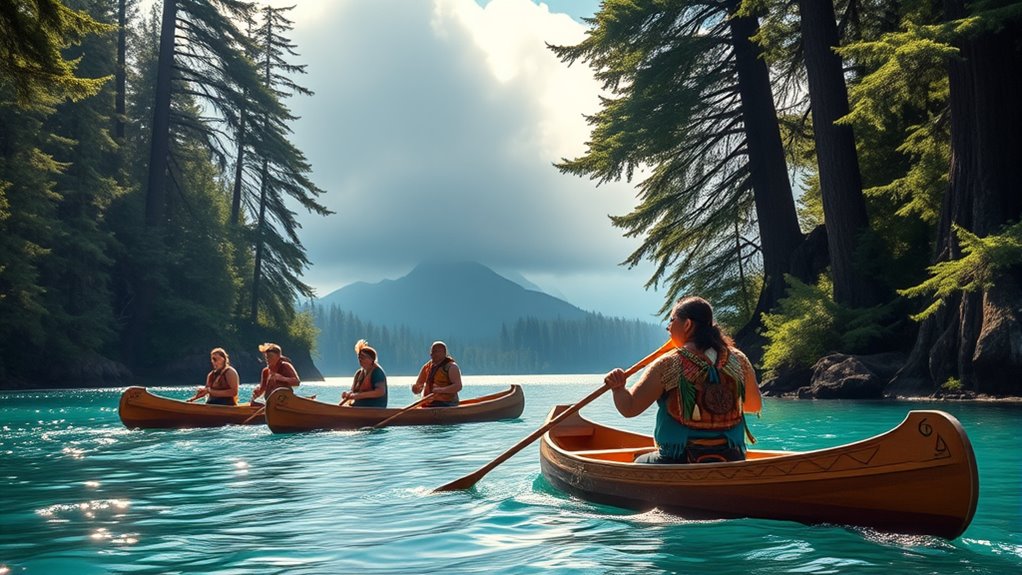
When you experience Haida communities, you participate in efforts to preserve their cultural heritage and traditional practices. These communities actively share their stories, art, and ceremonies to keep their culture alive. By engaging in these practices, you gain a genuine understanding of their rich history and ongoing traditions. Recognizing the importance of cultural preservation helps ensure these vibrant traditions are passed down through generations.
Cultural Heritage Preservation
Have you ever wondered how cultural heritage can be preserved through immersive experiences? When you engage with Haida communities, you’ll discover that Indigenous storytelling plays an essential role in passing down history, legends, and values. These stories connect you to the land, ancestors, and traditions, keeping them alive for future generations. You’ll also see traditional art forms, like carving, weaving, and painting, which serve as visual records of Haida culture. Participating in or observing these art practices helps preserve skills that might otherwise fade. By immersing yourself in these cultural expressions, you actively support the safeguarding of Haida heritage. Your involvement ensures that these authentic traditions continue to thrive, fostering a deeper understanding and appreciation of Haida identity. Natural materials used in these art forms further strengthen the connection between culture and the environment. Recognizing the importance of cultural preservation techniques further highlights the active role communities take in safeguarding their heritage. Embracing sustainable art practices also helps minimize environmental impact and promotes resilience in cultural expression.
Traditional Practices Engagement
Participating in traditional practices offered by Haida communities allows you to experience their rich cultural heritage firsthand. You might join in cultural rituals that have been passed down through generations, gaining insight into their spiritual and communal significance. Engaging in these rituals provides a meaningful connection to Haida history and values. Additionally, you’ll have the opportunity to listen to traditional storytelling, where elders share legends and lessons that preserve their identity. These stories breathe life into Haida culture, offering perspectives that deepen your understanding of their worldview. By actively participating in these cultural practices, you support the continuity of Haida traditions and forge a genuine connection with the community’s heritage. Recognizing the importance of cultural preservation is essential to understanding the significance of these practices, as they serve to maintain and celebrate the unique identity of the Haida people. It’s an authentic experience that leaves a lasting impression. Moreover, such engagement aligns with the broader efforts of indigenous communities to protect their cultural heritage, ensuring these traditions endure for future generations. Engaging in these practices also fosters a sense of community cohesion, which is vital for the resilience and vitality of Haida cultural life. Understanding cultural revitalization helps in appreciating how these practices contribute to the ongoing renewal of traditions and cultural pride. Building awareness of gaslighting tactics helps in understanding the importance of emotional safety and trust within communities, ensuring respectful and supportive interactions during cultural exchanges.
Land and Sea Adventures: Exploring Wilderness With Indigenous Guides
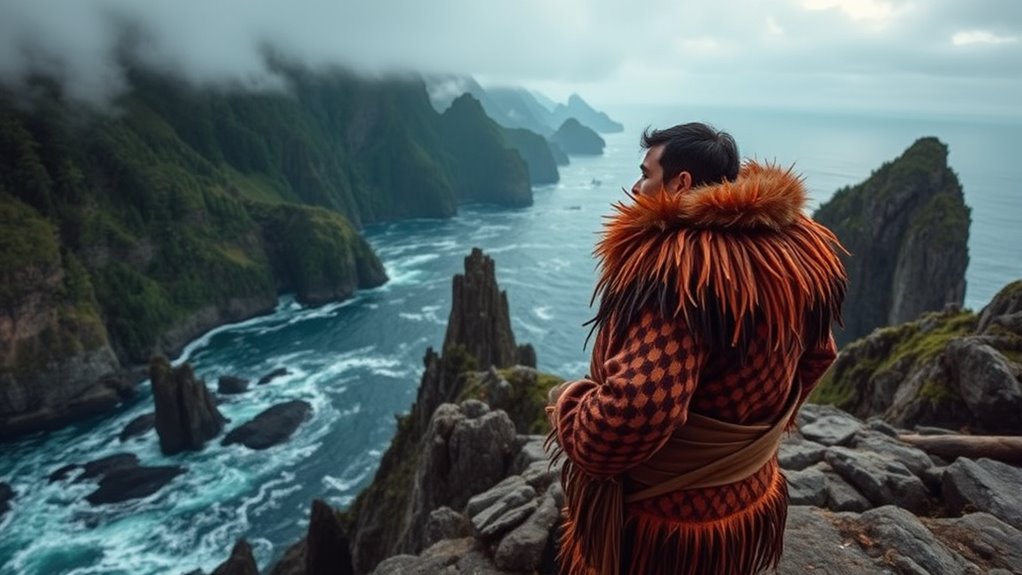
When you explore land and sea with Indigenous guides, you gain deeper insight into their cultural connection to the wilderness. These guided adventures highlight the land’s significance and the traditions tied to it. You’ll see firsthand how Indigenous communities preserve their heritage through responsible stewardship of these sacred spaces. Additionally, understanding the importance of cultural heritage preservation enriches your experience and supports Indigenous-led conservation efforts. Engaging in authentic eco-tourism experiences promotes sustainable practices that benefit both the environment and Indigenous communities. Ensuring safe and responsible exploration involves respecting local safety standards and regulations, which Indigenous guides are well-versed in.
Cultural Significance of Land
Why does the land hold such profound cultural significance for Indigenous communities? It’s more than a place; it’s a living connection to history, spirituality, and identity. Sacred sites mark locations where rituals are performed, connecting people to ancestors and the natural world. These sites serve as physical links to stories, teachings, and traditions. Ritual practices often involve ceremonies, offerings, and dances that honor the land’s spiritual power. Imagine standing on a sacred hill, feeling the energy of generations. Picture a hidden cedar grove where elders gather for rituals. Visualize ancestral carvings on ancient rocks, echoing stories. The land isn’t just scenery—it’s a essential part of cultural life, anchoring community, spirituality, and survival through its sacred sites and rituals.
Guided Wilderness Expeditions
Guided wilderness expeditions led by Indigenous guides offer a unique opportunity to immerse yourself in the land and sea through authentic, culturally informed experiences. As you explore, you’ll hear indigenous storytelling that shares deep connections to the landscape, history, and spiritual beliefs. These stories enrich your understanding of the area’s significance and bring the environment to life. Indigenous guides also demonstrate traditional craftsmanship, such as carving or weaving, giving you hands-on insight into ancestral skills. You’ll learn how these practices are woven into daily life and conservation efforts. This approach fosters a respectful, immersive experience that highlights Indigenous knowledge systems, allowing you to connect more meaningfully with the wilderness while gaining a deeper appreciation of its cultural importance.
Protecting Natural and Cultural Heritage Through Sustainable Practices
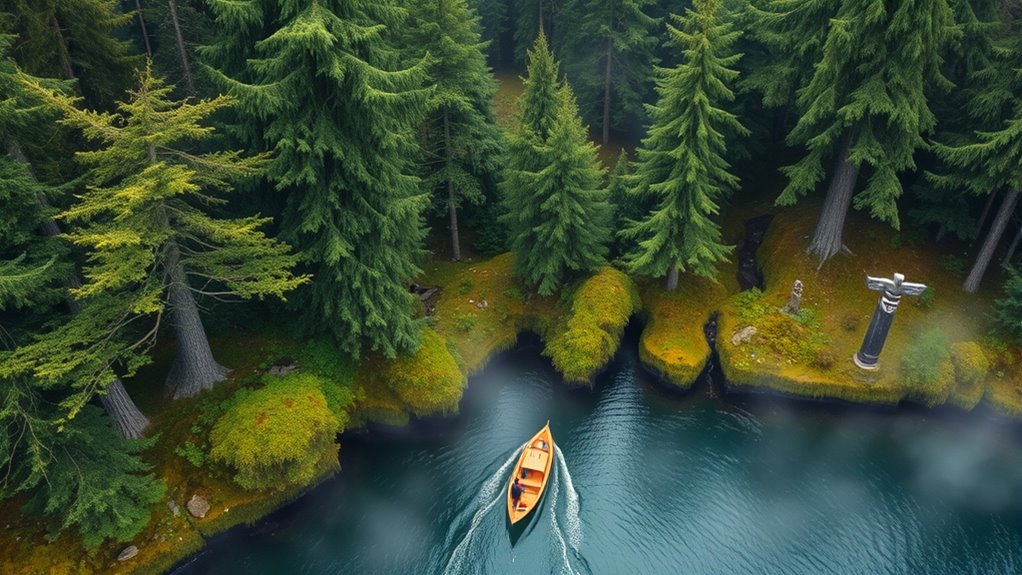
Protecting natural and cultural heritage is essential for ensuring that indigenous-led wilderness experiences remain authentic and sustainable. You can support this by engaging in practices that prioritize wildlife conservation and eco-friendly accommodations. These efforts help maintain the environment’s health and honor cultural traditions. Consider these strategies:
- Implementing wildlife conservation initiatives that protect local species and habitats.
- Using eco-friendly accommodations built with sustainable materials and low-impact designs.
- Supporting indigenous-led conservation projects that preserve cultural sites and practices.
- Promoting responsible tourism that respects local customs and minimizes environmental footprints.
Community-Driven Conservation Initiatives
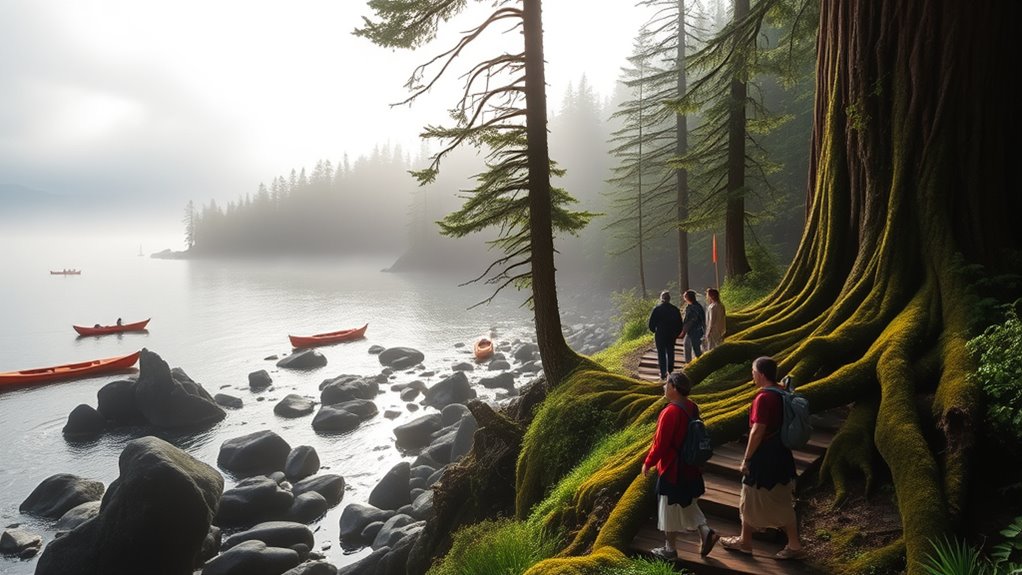
Community-driven conservation initiatives empower indigenous communities to take the lead in preserving their lands and resources. By prioritizing sustainable development, these efforts guarantee that environmental health and cultural traditions thrive together. You’ll see how local communities develop and implement their own conservation plans, focusing on protecting biodiversity and cultural sites. This approach fosters community empowerment, giving residents control over their natural resources and decision-making processes. It encourages collaboration with government agencies and NGOs, making conservation more effective and culturally relevant. These initiatives often include traditional practices, such as sustainable harvesting and habitat restoration, which support long-term ecological balance. Ultimately, community-driven efforts create resilient ecosystems while strengthening indigenous sovereignty and ensuring future generations can enjoy their lands.
How Visitors Can Respect and Support Indigenous Tourism

Supporting indigenous tourism means actively respecting the cultures, traditions, and lands that communities have worked hard to preserve. To do this, you can:
- Engage with local art by purchasing authentic crafts and learning about their cultural significance.
- Respect culinary traditions by trying traditional foods and supporting indigenous-owned eateries.
- Listen carefully to guides and elders, honoring their stories and teachings about the land.
- Follow guidelines for land use and cultural sites, ensuring your presence doesn’t disturb sacred spaces.
Future Opportunities for Indigenous-Led Ecotourism in Haida Gwaii
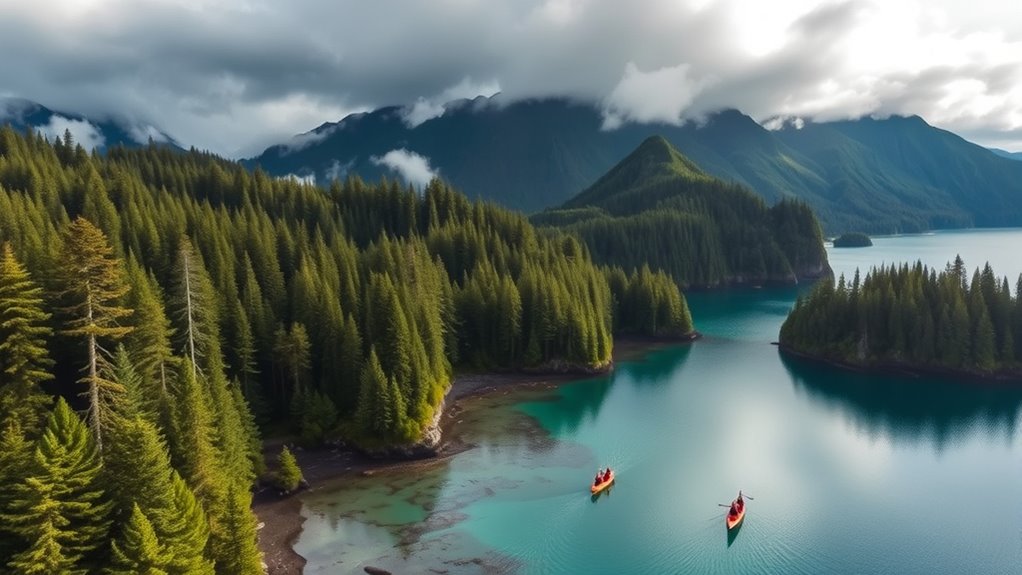
How can Haida Gwaii expand its indigenous-led ecotourism opportunities in the future? One way is through eco lodge development that emphasizes sustainability and cultural authenticity. These lodges can serve as hubs for immersive experiences, connecting visitors directly with Haida traditions. Additionally, fostering Indigenous art collaborations can showcase local craftsmanship and storytelling, enriching visitor engagement. To access these opportunities, consider this table:
| Opportunity | Impact |
|---|---|
| Eco lodge development | Boosts sustainable tourism and local economy |
| Indigenous art collaborations | Preserves culture and enhances visitor experience |
| Community-led initiatives | Guarantees authentic representation |
| Partnerships with tour operators | Expands reach and accessibility |
Frequently Asked Questions
How Do Indigenous-Led Tours Differ From Mainstream Tourism Experiences?
You’ll notice that indigenous-led tours focus on authentic cultural preservation and environmental stewardship, offering a deeper connection to the land and traditions. Unlike mainstream experiences, they prioritize respectful storytelling, community involvement, and sustainable practices. You get to learn directly from Indigenous guides, gaining insights into their history and environment. This approach fosters genuine understanding and supports the preservation of their culture and natural resources for future generations.
What Training Do Indigenous Guides Undergo for Wilderness Adventures?
Imagine a guide holding the key to nature’s secrets. You’ll find they undergo rigorous training in traditional skills, like bushcraft, navigation, and storytelling, blending ancient knowledge with modern safety practices. They also focus on environmental stewardship, learning how to protect delicate ecosystems while sharing their cultural heritage. This training guarantees you’re in capable hands, experiencing wilderness adventures that honor both nature and Indigenous traditions.
Are There Options for Visitors With Limited Mobility or Special Needs?
You’ll find adaptive access and inclusive options available, ensuring everyone can enjoy the wilderness. Many tour operators and guides provide accommodations for visitors with limited mobility or special needs, such as accessible trails and equipment. It’s best to contact providers in advance to discuss your specific requirements. They’re committed to creating an inclusive experience, so you can explore the natural beauty of Haida Gwaii comfortably and confidently.
How Do Indigenous Communities Ensure Tourism Benefits Local Residents?
You might wonder how indigenous communities ensure tourism benefits local residents. They do this by focusing on cultural preservation and community empowerment, making sure tourism supports their traditions and economy. By involving local people in decision-making and promoting authentic experiences, they create sustainable benefits. This approach helps preserve their heritage while allowing residents to thrive economically and socially, guarantee tourism uplifts the entire community.
What Are the Challenges Faced in Maintaining Cultural Authenticity in Tourism?
You face authenticity challenges when maintaining cultural preservation in tourism. As you showcase your traditions, there’s a risk of commercialization or misrepresentation, which can dilute your culture’s true essence. Balancing sharing stories and practices with protecting your cultural integrity is tough. You must actively collaborate with your community, set clear boundaries, and educate visitors, ensuring that tourism respects and sustains your cultural heritage for future generations.
Conclusion
As you explore Haida Gwaii’s wilderness, you’ll discover it’s more than just stunning landscapes—it’s a place where Indigenous stories and traditions come alive. By engaging respectfully with communities and supporting their sustainable practices, you become part of a meaningful journey. Sometimes, the most unexpected moments—like a shared laugh with a local guide—leave the deepest impact. Embrace these experiences, and you might find yourself forever connected to this extraordinary land and its people.


